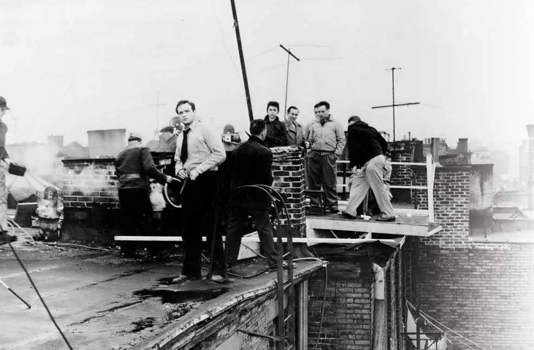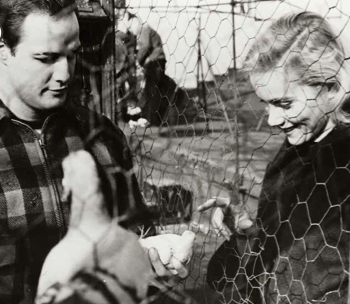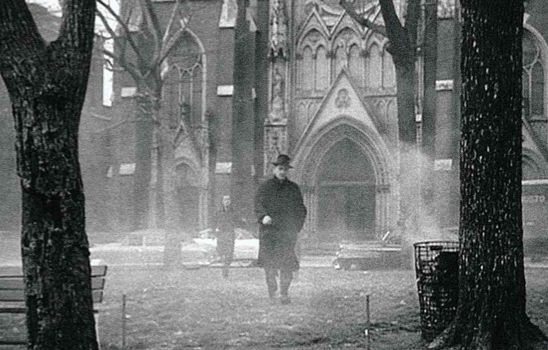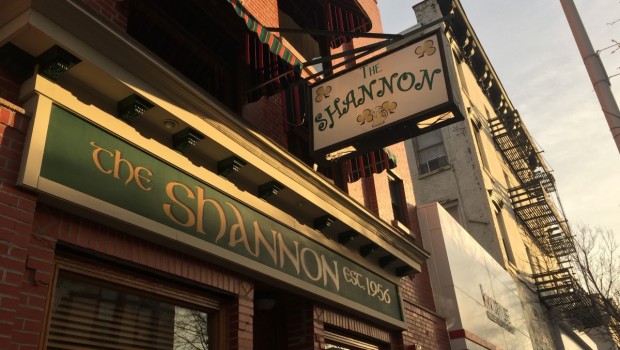
“On the Waterfront,” Starring… Hoboken!
Story by Melissa Abernathy
Photos courtesy of Hoboken Historical Museum
Although our town doesn’t even earn a credit in the movie, Hoboken arguably played a more vital role in clinching the Academy’s Best Picture for On the Waterfront, than the Oscar-winning performances of Marlon Brando and Eva Marie Saint.
Just how important Hoboken was to the film’s heart and soul was revealed decades later by director Elia Kazan. “I had a problem right away,” he told Jeff Young in an early 1970s interview. “The actors had to be in the same league as the scenery. They had to be as real as Hoboken.”
Without a connection to Hoboken, one might not even know the movie was filmed nearly entirely on location here in the winter of 1953-1954—at working docks, local bars, churches and parks, and on the rooftops of tenement apartment buildings. Even the interiors were shot in Hoboken.
British Film Institute historian Leo Braudy wrote, “The neighbourhood in which the events of the film take place…becomes a central part of the film’s power, the authentic feel of a real place.”
Sixty years later, it’s hard to picture the blue-collar Hoboken that shaped the script and set the tone for the film. Most traces of the bustling piers have extinguished, replaced with parks and recreation space. The dingy bars and threadbare tenements that catered to the piers’ longshoremen have been replaced with high-rise condos and sleek restaurants.
But Hoboken’s bone structure is intact, if you know where to look.
A guided tour is just a click away at the Hoboken Historical Museum’s website, hobokenmuseum.org. Under the “Self-Guided Walking Tours” tab is an annotated Google map guide compiled by Museum Associate Darian Worden, which lists many of the sites that appear in the movie, illustrated with images from the Museum’s collections.
Some of the locations are recognizable, including Our Lady of Grace Church, Saints Peter and Paul Catholic Church, and the alleyway of Court Street, below Newark, where a truck almost bumps off Terry Malloy and Edie Doyle. Hardly changed are Church Square Park with its stately sycamore trees, and Elysian Park, where the iron fence overlooking the Hudson still stands strong. Others have long since vanished, like Pier C itself, and the tiny floating clubhouse that once belonged to the Hoboken Yacht Club, which also served as the headquarters of mob-connected union boss Johnny Friendly.
Screenwriter Budd Schulberg spent nearly a year researching and writing this beautifully realistic, gritty account of the plight of working-class Americans. He was inspired by New York Sun reporter Malcolm Johnson’s Pulitzer Prize-winning investigative series on corruption in the longshoremen’s unions all around New York Harbor. At the center of Johnson’s account was the crusading West Side priest, Father John Corridan, who became Karl Malden’s character, Father Barry, in the movie.
Schulberg sought out Corridan, who regaled him with stories of corruption, crime, and murder, and then introduced him to a “docker,” Arthur “Brownie” Brown, who took him around to the bars and piers on both sides of the Hudson. He described scenes of the waterfront musclemen counting up kick- back money and parceling it out to his lieutenants. Brown also showed Schulberg a shape-up, a barbaric system in which too few jobs were handed out to select longshoremen, usually based on who were willing to pay kickbacks for steady work. All these stories made their way into the movie.




 Previous Article
Previous Article Next Article
Next Article REMEMBERING THE FIRES: All Saints Church to Commemorate Those Lost in Series of Hoboken Fires
REMEMBERING THE FIRES: All Saints Church to Commemorate Those Lost in Series of Hoboken Fires  120th Annual Hoboken Memorial Day Parade – WEDNESDAY, MAY 23 @ 6:30 P.M. ON WASHINGTON STREET
120th Annual Hoboken Memorial Day Parade – WEDNESDAY, MAY 23 @ 6:30 P.M. ON WASHINGTON STREET  “Every Mask a Blank Canvas” — Hoboken Historical Museum Announces Winners of COVID-19 Art Competition
“Every Mask a Blank Canvas” — Hoboken Historical Museum Announces Winners of COVID-19 Art Competition  SLÁINTE: The Shannon — Hoboken’s Legendary Irish Bar Since 1956 — Set to Change Ownership
SLÁINTE: The Shannon — Hoboken’s Legendary Irish Bar Since 1956 — Set to Change Ownership  FRIDAYS ARE FOR FRANK: “Come Blow Your Horn”
FRIDAYS ARE FOR FRANK: “Come Blow Your Horn”  FRIDAYS ARE FOR FRANK: “Dark Eyes” (feat. Jimmy Durante)—Sinatra Sings in Russian
FRIDAYS ARE FOR FRANK: “Dark Eyes” (feat. Jimmy Durante)—Sinatra Sings in Russian  FRIDAYS ARE FOR FRANK: “I’m Gonna Sit Right Down And Write Myself A Letter” (USPS Edition)
FRIDAYS ARE FOR FRANK: “I’m Gonna Sit Right Down And Write Myself A Letter” (USPS Edition)  FRIDAYS ARE FOR FRANK: “The Way You Look Tonight”
FRIDAYS ARE FOR FRANK: “The Way You Look Tonight”